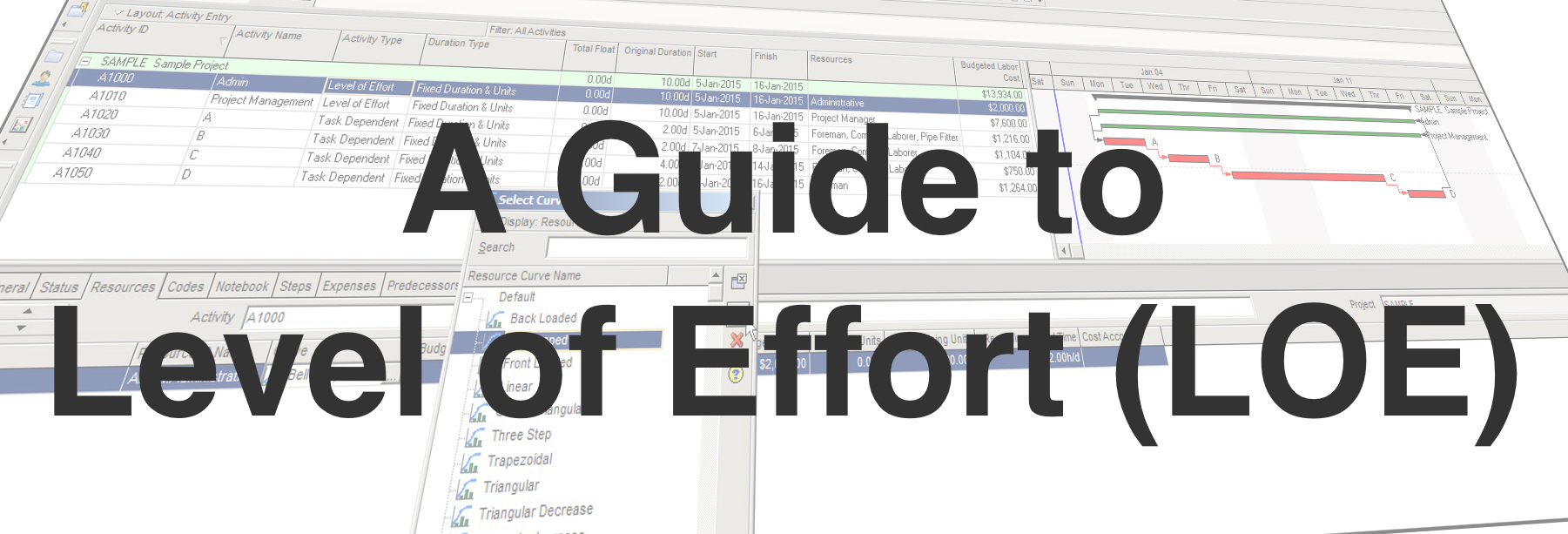

If you work in an environment with earned value management, you’ll probably have come across Level of Effort (LOE). And you might have seen the accompanying eye rolls as people tried to justify why it was important that their work is tracked with LOE and not in any other way. So what is it all about? Let’s demystify LOE once and for all.
Level of effort (LOE) refers to tasks that are the management overhead of running a project and that don’t produce any specific, defined end products as part of the project. There’s no specific measurable outcome in terms of deliverables. Instead, it is a specific activity type that represents the discrete effort, the sustaining work of delivery where time is the only way to measure that it is happening.
To give you a better understanding of what LOE activities might look like on your schedule, let’s share some examples. Here are some tasks that would be classified as LOE activities:
Those are all essential things that happen on many projects, but can’t easily be measured in terms of output. The work involved depends on the phase of the project and what’s required that month. While there might always be some low-level involvement, the exact level of relationship management might look very different from month to month.
For example, your team will spend more time on relationship building and making a good impression with the client at the beginning of your engagement when the team is forming. As you fall into a regular cadence of meetings and a working relationship, there might be less active relationship management to do until a problem arises. The same goes for project management. While one month might be full on with phone calls and project support activities, another might not have very much at all. If you can estimate for this, do so, as it will make your schedule quality that much better.
Level of effort activities still need to be budgeted and planned, and ideally that is done in separate control accounts. Split the work in the work breakdown structure so that level of effort tasks are managed separately from activities that can be tracked in other ways. If you can’t do that, try to limit the total amount of LOE work that falls into a single work package so that the overall work package performance is not skewed by the LOE tracking.
For example, some months have five weeks, others have four, and that will affect how many hours are spent on program management. Typically, projects have more of a management overhead at the beginning, where the project manager may be full time on setting up the project and kicking off the work. That may drop to a lower overhead of project management tasks during the execution phase and pick up again towards the end.
All these variations should be thought through and considered in the schedule when LOE tasks are added. Don’t simply say, “It’s 10 hours per month,” and pop that into the work package for every month. Apportioned effort should be split in a reasonable and realistic way.
Because a level of effort activity doesn’t have any measurable products, you can only track it by the passage of time. In other words, as time passes, the work is considered as performed. The current budget value for the time period is marked as earned, as there really isn’t any other way of demonstrating whether it was or not. That means schedule variance for LOE tasks is always zero and BCWP equals BCWS every time. This is the standard, acceptable way of tracking project performance for tasks with LOE.
As LOE is difficult to measure, as a control account manager you should try to avoid having too many tasks in an earned value management environment that rely on it. Otherwise too many project management activities are tracked simply by hours passing and not on tangible outcomes and deliverables achieved during the time.
Use a uniform set of work performance rates to track the cost impact. For example, different resources in the team could be charged at different rates. Your PMO probably has some best practices for this.
As we’ve seen, there is no project schedule variance for LOE tasks. However, you might find that cost variances show themselves with LOE tracking, and that is useful for team members to see as part of creating an accurate budget report.
Project management software like Oracle Primavera P6 will help highlight variances across your project schedule and reduce the administrative work required in trying to identify where things are not going to plan. Use out of the box reporting or create tailored reports to help with the planning phase and with creating an accurate Gantt chart where level of effort is shown in an appropriate way.
The use of LOE can’t often be avoided, so it is worth having an approach to it that is appropriate for the size of the project. Different projects may need to take a different approach, and of course they will have different requirements for support personnel, who often find themselves the driver for this particular type of activity.
It’s really important to get Level of Effort (LOE) tasks scheduled and budgeted for correctly as otherwise your project estimates will be incorrect, and that can cause issues with stakeholders and clients later in the project. Accurate scheduling can be difficult to do, and not having the time or people to schedule is one of the main reasons why organizations often choose to outsource scheduling to people who do it daily. If you don’t have in-house schedule experts, why not buy in someone on a contract basis who can ensure that your Level of Effort (LOE) tasks – and everything else – are accurately reflected in a detailed, achievable schedule?